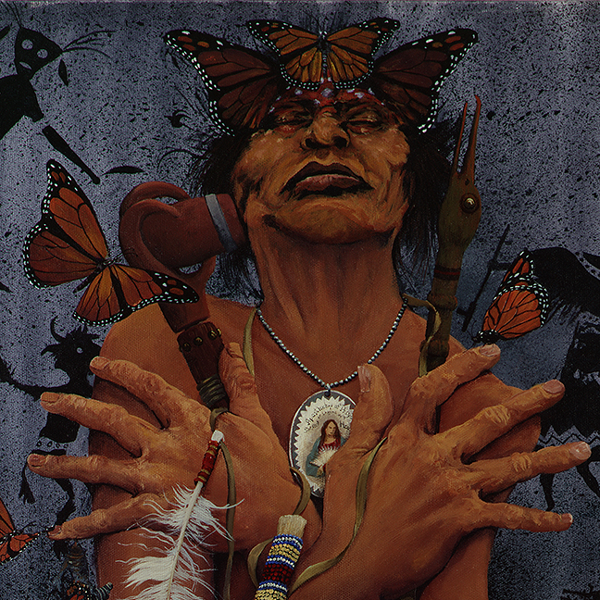Tulsa-based artist Robert Taylor combines significant symbolism with traditional and contemporary Native American themes in his evocative paintings. The Fred Jones Jr. Museum of Art at the University of Oklahoma opens a new exhibition of works by the artist spanning three decades with a public lecture and reception from 7 to 9 p.m. Thursday, Oct. 5. The exhibition officially opens to museum visitors the following day at 10 a.m.
The opening events, as well as valet parking, are complimentary.
Taylor serves as the sixth guest artist in the university’s Jerome M. Westheimer, Sr. and Wanda Otey Westheimer Distinguished Visiting Artist Chair program. Past visiting artists have included James Surls, Christine Nofchissey McHorse and Hung Liu.
“The Jerome M. Westheimer, Sr. and Wanda Otey Westheimer Distinguished Visiting Artist program provides the opportunity for the Fred Jones Jr. Museum of Art to exhibit the work of a contemporary artist of significant merit,” said Mark White, the museum’s Wylodean and Bill Saxon Director.
“This year, we are extremely pleased to host Robert Taylor as the sixth guest artist,” he said. “In addition to the exhibition, Taylor will work with the students of the OU School of Visual Arts. This important program would not be possible without the generosity of Mrs. Wanda Otey Westheimer and her family and, on behalf of the Board of Visitors of the Fred Jones Jr. Museum of Art and the OU Weitzenhoffer Family College of Fine Arts, I would like to express our utmost appreciation for their continued support.”
Taylor was born in Tulsa in 1951, and is of Blackfeet, Cherokee, Osage, Crow, Scottish and Black Dutch descent. Largely self-taught, Taylor borrows from multiple styles and genres such as Surrealism and Magic Realism to create mystical and often enigmatic images of nature, Native American tribal life and spiritual rituals. Drawing inspiration from artists such as Paul Pletka, John Biggers and Salvador Dali, Taylor tends toward a naturalistic representation, though he often exaggerates bodily proportions as a symbolic device to acknowledge the human connection to the earth and sky.
Butterflies, feathers, skulls and rainbows are just a few of the recurring images in Taylor’s work. Taylor says these images are part of his artistic lexicon.
“It helps with the vocabulary in your paintings and gives you another symbol of sorts to guide [viewers] around to what you’re trying to talk about,” Taylor said.
Taylor warns, however, not to take symbols at face value.
“I can only speak personally for myself but, for me, the symbology that I use changes once I label something,” he said. “As an artist, if you’re trying to convey a thought or a meaning, you have to have people understand your vocabulary, and that’s my vocabulary. What you almost want to do is put a legend at the bottom of each painting: an egg represents this and the cross actually represents this.”
Taylor’s paintings often depict figures from Native American life at the end of the reservation era, around the turn of the 20th century, but his interest in mysticism often gives the work an enigmatic tone. He describes his deeply symbolic works as a response to a variety of religious traditions.
Taylor attended Central Missouri State and the University of Tulsa, though he never completed a formal education. He was drafted into the Navy, where he served from 1970 to 1972. Taylor has exhibited and received awards from the Trail of Tears exhibition at the Cherokee National Museum in Tahlequah, the Five Civilized Tribes Museum, the Gallup Inter-Tribal Indian Ceremonial, the Los Angeles Contemporary Art Fair, the Red Earth Festival and the Smithsonian Institution. In 2005, he was commissioned by the State of Oklahoma to create a triptych commemorating the U.S. marshals who served in Indian Territory.
In addition to works on display inside the museum, multiple works are on display inside the OU Health Sciences Center’s Robert M. Bird Health Sciences Library and several locations on the OU Norman campus.



